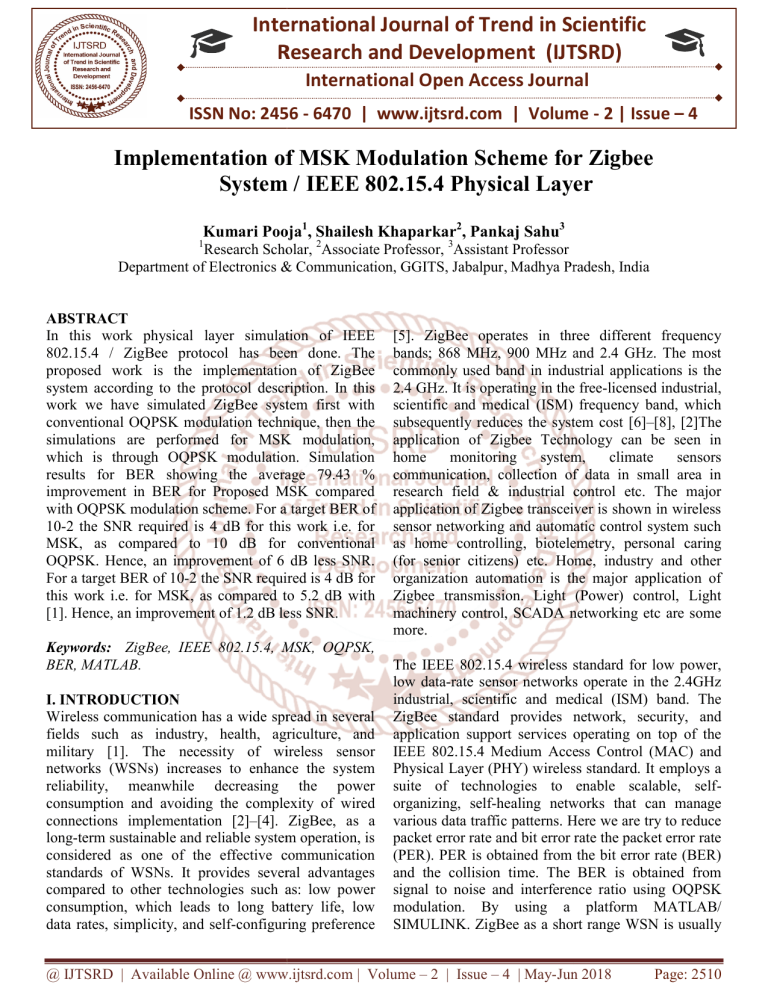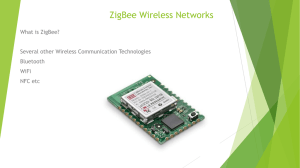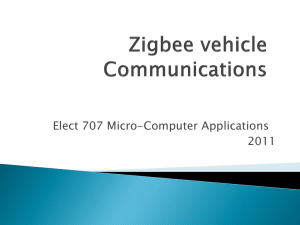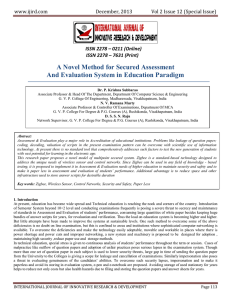
International Journal of Trend in Scientific
Research and Development (IJTSRD)
International Open Access Journal
ISSN No: 2456 - 6470 | www.ijtsrd.com | Volume - 2 | Issue – 4
Implementation off MSK Modulation Scheme for
or Zigbee
System / IEEE 802.15.4 Physical Layer
Kumari Pooja1, Shailesh Khaparkar2, Pankaj Sahu3
1
Research Scholar, 2Associate Professor, 3Assistant Professor
Department of Electronics & Communication, GGITS, Jabalpur
Jabalpur, Madhya Pradesh,
Pradesh India
ABSTRACT
In this work physical layer simulation of IEEE
802.15.4 / ZigBee protocol has been done. The
proposed work is the implementation of ZigBee
system according to the protocol description. In this
work we have simulated ZigBee system first with
conventional OQPSK
PSK modulation technique, then the
simulations are performed for MSK modulation,
which is through OQPSK modulation. Simulation
results for BER showing the average 79.43 %
improvement in BER for Proposed MSK compared
with OQPSK modulation scheme. For a targ
target BER of
10-22 the SNR required is 4 dB for this work i.e. for
MSK, as compared to 10 dB for conventional
OQPSK. Hence, an improvement of 6 dB less SNR.
For a target BER of 10-22 the SNR required is 4 dB for
this work i.e. for MSK, as compared to 5.2 dB wit
with
[1]. Hence, an improvement of 1.2 dB less SNR.
Keywords: ZigBee, IEEE 802.15.4, MSK, OQPSK,
BER, MATLAB.
I. INTRODUCTION
Wireless communication has a wide spread in several
fields such as industry, health, agriculture, and
military [1]. The necessity of wireless sensor
networks (WSNs) increases to enhance the system
reliability, meanwhile decreasing the power
consumption and avoiding the complexity of wired
connections implementation [2]–[4].
[4]. ZigBee, as a
long-term
term sustainable and reliable system operation, is
considered as one of the effective communication
standards of WSNs. It provides several advantages
compared to other technologies such as: low power
consumption, which leads to long battery life, low
data rates, simplicity, and self-configuring
configuring preference
[5]. ZigBee operates in three different frequency
bands; 868 MHz, 900 MHz and 2.4 GHz. The most
commonly used band in industrial applications is the
2.4 GHz. It is operating in the free-licensed
free
industrial,
scientific and medical (ISM) frequency band, which
subsequently reduces the system cost [6]–[8],
[6]
[2]The
application of Zigbee Technology can be seen in
home
monitoring
ing
system,
climate
sensors
communication, collection of data in small area in
research field & industrial control etc. The major
application of Zigbee transceiver is shown in wireless
sensor networking and automatic control system such
as home controlling,, biotelemetry, personal caring
(for senior citizens) etc. Home, industry and other
organization automation is the major application of
Zigbee transmission. Light (Power) control, Light
machinery control, SCADA networking etc are some
more.
The IEEE 802.15.4
5.4 wireless standard for low power,
low data-rate
rate sensor networks operate in the 2.4GHz
industrial, scientific and medical (ISM) band. The
ZigBee standard provides network, security, and
application support services operating on top of the
IEEE 802.15.4 Medium
edium Access Control (MAC) and
Physical Layer (PHY) wireless standard. It employs a
suite of technologies to enable scalable, selfself
organizing, self-healing
healing networks that can manage
various data traffic patterns. Here we are try to reduce
packet error rate and bit error rate the packet error rate
(PER). PER is obtained from the bit error rate (BER)
and the collision time. The BER is obtained from
signal to noise and interference ratio
r
using OQPSK
modulation. By using a platform MATLAB/
SIMULINK. ZigBee as a short range WSN is usually
@ IJTSRD | Available Online @ www.ijtsrd.com | Volume – 2 | Issue – 4 | May-Jun
Jun 2018
Page: 2510
International Journal of Trend in Scientific Research and Development (IJTSRD) ISSN: 2456-6470
used in indoor environments, in which it is subjected
to the effects of wireless propagation, such as added
noise and multipath fading. These effects may cause
inter-symbol interference (ISI), increase the bit error
rate (BER ) at the receiver, and decrease the reliability
of the entire system [9].
Here a comparatively analysis of Zigbee, Bluetooth
and Wi-Fi technology is also present that will help us
that how Zigbee is different than other wireless
networking technologies [3]:
Some of the characteristics of ZigBee include:
Global operation in the 2.4GHz frequency band
according to IEEE 802.15.4 Regional operation in the
915Mhz (Americas) and 868Mhz (Europe).
Frequency agile solution operating over 16 channels
in the 2.4GHz frequency Incorporates power saving
mechanisms for all device classes Discovery
mechanism with full application confirmation Pairing
mechanism with full application confirmation
Multiple star topology and inter-personal area
network (PAN) communication Various transmission
options including broadcast Security key generation
mechanism Utilizes the industry standard AES-128
security scheme Supports Alliance standards (public
application profiles) or manufacturer specific profiles.
III. ZIGBEE / IEEE
ARCHITECTURE
802.15.4
PROTOCOL
Table 1: comparison of ZigBee with other protocols
II. ZIGBEE AND IEEE802.11.4
SPECIFICATIONS
Zigbee Alliance was established in August, 2001,The
ZigBee specification, officially named ZigBee 2007.It
offers full wireless mesh networking capable of
supporting more than 64,000devices on a single
network. It’s designed to connect the widest range of
devices, in any industry, into a single control network.
The ZigBee specification has two implementation
options or Feature Sets: ZigBee and ZigBee PRO. The
ZigBee Feature Set is designed to support smaller
networks with hundreds of devices in a single
network. The ZigBee PRO Feature Set is the most
popular choice of developers and the specification
used for most Alliance developed ZigBee Feature Set,
plus facilitates ease-of-use and advanced support for
larger networks comprised of thousands of devices.
Both Feature Sets are designed to interoperate with
each other, ensuring long-term use and stability. The
ZigBee specification enhances the IEEE 802.15.4
standard by adding network and security layers and an
application framework. From this foundation,
Alliance developed standards, technically referred to
as public application profiles, can be used to create a
multi-vendor interoperable solutions. For custom
application where interoperability is not required,
manufacturers can create their own manufacturer
specific profiles.
Figure 2: ZigBee/IEEE 802.15.4 Architecture
II. F. FREQUENCY BANDS AND DATA RATES
The standard specifies two PHYs:
1. 868 MHz/915 MHz direct sequence spread
spectrum (DSSS) PHY (11channels) 1 channel
(20Kb/s) in European 868MHz band 10 channels
(40Kb/s) in 915 (902-928)MHz ISM band.
2. 2450
MHz
direct
sequence
spread
spectrum(DSSS) PHY (16 channels) 16 channels
(250Kb/s) in 2.4GHz band.
III. ZigBee System
The main objective of this work is to simulate and
physical level simulation of IEEE 802.15.4 ZigBee
protocol. For this we have simulated the ZigBee
system for IEEE 802.15.4. In this process first we
@ IJTSRD | Available Online @ www.ijtsrd.com | Volume – 2 | Issue – 4 | May-Jun 2018
Page: 2511
International Journal of Trend in Scientific Research and Development (IJTSRD) ISSN: 2456-6470
have implemented the ZigBee system with existing
OQPSK modulation, than the system is being
implemented using MSK using OQPSK by using
platform MATLAB.
Table 2:Frequency Bands & Data Rates of ZigBee
IV.
A comprehensive model for ZigBee transceiver has
been built in MATLAB Simulink. The details of this
model are presented in this section. A block diagram
for the transceiver model is shown in Fig. 3.
A. ZigBee Transmitter Model
Before transmitting the input data through the
transmission channel, three stages of signal
processing are required: signal generation, spreading
and modulation, as depicted in Fig. 3.
1. Binary Generator: Each four bits of input data
stream of 250 kbps is mapped into a symbol [3].
Thus, the symbol rate is 62.5 Kilo symbols per
second. The ‘Random Integer Generator’ in the
Simulink library is used with 2-ary number and
1/250000 sampling time.
2. Pseudo-Noise (PN) Sequence Generator: This
block in Simulink is used to generate the 16-ary
PN sequences with 32-bit chip sequence, where
the chip rate is 2Mcps.
3. Direct Sequence Spread Spectrum (DDSSS)
Spreading:
The symbol is used to select one of the 16-ary PN
sequences resulting in 2 Mega DSSS. In Simulink,
this process is performed through two steps: first,
the input data stream and PN code are converted
to non-return-tozero (NRZ) format, and then they
are multiplied to generate a wide-band DSSS
signal. Pulse shaping is achieved using the half
sine signal as given in Eq.1
Eq.1
where,T is the chip period.
4. Offset Quadrature Phase Shift Keying (OQPSK)
Modulation: The spread signal is modulated using
OQPSK modulation and transmitted over the
fading
channel.
B. Channel Characteristics
The widespread AWGN is used to simulate
background noise of the time-varying channel. The
medium of the data transfer is closed, and thus there
are multipath fading effects. Since ZigBee is generally
used in a closed environment, it will be affected by
small-scale
Rayleigh
and
Rician
fading.
Obstacles in the transmission path of the signal result
in multipath copies of the signal with different delay
times. If
denotes the complex path gain and
defines the path delay of the signal via the
path,
then the impulse response of the channel is given by:
where,
is the input sampling period, and nis the
number of samples. By referring to the set of samples
at the input of the channel as
, then the output is
given by:
In case of Rayleigh fading, there is no direct path
along a line of sight, and all received signals are
reflected copies. The ‘Multipath Rayleigh Fading
Channel’ block is used in the model with 0.001 max
Doppler shift. In Rician fading, there is a signal
component with direct path to the receiver. The
‘Multipath Rician Fading Channel’ Simulink block is
used with k-factor of 1 to model this effect. The kfactor represents the ratio between the power in the
line-of-sight component, and the power in the diffused
component. Four multipath components with path
delays [0, 1, 5, 10] ns and average path gains of [0, -2,
-3, -5] dB are used for simulation. To match the
realistic channel, all these impacts are considered
during the model design.
C. ZigBee Receiver Model
The original signal is extracted by adding a filter
and/or an equalizer to the receiver model. The filter is
used to remove the added noise on the signal, and the
equalizer works to compensate the unwanted impact
of the channel such as attenuation, amplification,
delay
and
phase
shift.
In
this
work
an adaptive linear equalizer is added to the receiver
model to achieve the two tasks at the same time. The
signal is obtained at the receiver by using OQPSK
demodulation block. The received 2 Mbps signal is
de-spreaded by using the same PN sequence, which
was used at the transmitter side. The received
signaland the PN sequence must be synchronized
before multiplication.
@ IJTSRD | Available Online @ www.ijtsrd.com | Volume – 2 | Issue – 4 | May-Jun 2018
Page: 2512
International Journal of Trend in Scientific Research and Development (IJTSRD) ISSN: 2456-6470
IV. PROPOSED ALGORITHM
Figure 3: Proposed Algorithm
V. SIMULATION RESULTS
In this work physical layer MSK modulation
implementation of IEEE 802.15.4 ZigBee has been
done. First with the help of existing OQPSK
modulation technique the IEEE 802.15.4 ZigBee
protocol, system was implemented, then using MSK
through OQPSK modulation the system was
implemented again. Several MATLAB/Simulink
simulations were done to evaluate the performance of
Zigbee/IEEE 802.15.4 physical layer. The simulation
results show how the BER versus the SNR values
were affected when varying communication
parameters such the input data rate, the level of the
AWGN power and number of bits per symbol.
V. SIMULATION RESULTS
Figure 4: BER Performance of ZigBee for OQPSK &
MSK
@ IJTSRD | Available Online @ www.ijtsrd.com | Volume – 2 | Issue – 4 | May-Jun 2018
Page: 2513
International Journal of Trend in Scientific Research and Development (IJTSRD) ISSN: 2456-6470
Table 2: Simulation Results Comparison with [1]
VI. CONCLUSION
REFERENCES
1. Asmaa M. Romia et al, “Design Optimization of
LMS-Based Adaptive Equalizer for ZigBee
Systems with Fading Channels”, IEEE
International
Conference
on
Computing,
Mathematics and Engineering Technologies –
iCoMET 2018.
2. Soumen Moulik et al, “Performance Evaluation
and Delay-Power Trade-off Analysis of ZigBee
Protocol”, IEEE Transactions on Mobile
Computing, 2018.
3. Trio Adiono et al, “Zigbee Baseband Hardware
Modeling for Internet of Things IEEE 802.15.4
Compliance”, IEEE 6th International Conference
on Electrical Engineering and Informatics
(ICEEI), 2017.
4. Pere Pala et al, “Superregenerative Reception of
Narrowband
FSK
Modulations”,
IEEE
Transactions on Circuits & Systems-I: Regular
Papers, Vol. 62, No. 3, March 2015.
5. Varshney et al., “Comparative Analysis of
OQPSK and MSK Based ZigBee Transceiver
Using MATLAB”, International Journal of
Advanced Research in Computer Science and
Software Engineering 3(6), Pp. 948-956, June 2013.
6. Irfan Ali et al , “Bit-Error-Rate (BER) Simulation
Using MATLAB”, International Journal of
Engineering Research and Applications (IJERA)
ISSN: 2248-9622 ,Vol. 3, Issue 1, Pp.706-711,
February 2013.
7. Kapil Dev Jha et al, “Design & Simulation of
ZigBee Transceiver System Based on MSK and
QPSK Using MATLAB”, International Journal of
New Trends in Electronics and Communication
(IJNTEC) ,Vol.1, Issue. 4, Nov. 2013.
8. Wei Yuan et al, “Coexistence Performance of
IEEE 802.15.4 Wireless Sensor Networks
Under
IEEE
802.11b/g Interference”,
International Journal Distributed Sensor Networks
volume 2010(2010),Article ID581081,Pp -6,2010.
9. G. M. Tamilselvan and Dr. A. Shanmugam,
“Probability Analysis of channel collision
between IEEE 802.15.4 and IEEE 802.11b
using
Qualnet
Simulation
for
various
Topologies” International Journal of Computer
Theory and Engineering, Vol. 1, No. 1, April
2009.
10. NazifCihanTas et-al, “IEEE 802.15.4 Throughput
Analysis under IEEE 802.11 Interference”
International Symposium on Innovations and Real
Time Applications of Distributed Sensor
Networks, 2007.
11. Yuan, W., Linnartz, J. P. M. G., & Niemegeers,
“Adaptive CCA for IEEE 802.15.4 wireless sensor
networks to mitigate interference” IEEE wireless
communications and networking conference
Sydney, pp.1–5,2010.
12. Z. Alliance, “ZigBee Alliance,” WPAN industry
group, the industry group responsible for the
ZigBee standard and certification, 2010.
13. C. V. Berta, D. P. A. Rodolfo, R. Susan, and P.
Dirk, “Experimental evaluation of beacon
scheduling mechanisms for multi hop IEEE
802.15.4 wireless sensor networks,” in
Proceedings of the 4th International Conference
on Sensor Technologies and Applications (Sensor
Comm '10), pp. 226–231, July 2010
14. S. Ahmed, “The Role of ZigBee Technology in
Future Data Communication System, ”Journal of
Applied Information Technology, vol. 5, no. 2, pp.
129 – 135, 2009.
@ IJTSRD | Available Online @ www.ijtsrd.com | Volume – 2 | Issue – 4 | May-Jun 2018
Page: 2514
International Journal of Trend in Scientific Research and Development (IJTSRD) ISSN: 2456-6470
2456
15. IEEE Standard for Local and Metropolitan Area
Networks-Part 15.4: Low-Rate
Rate Wireless Per
Personal
Area Networks (LR-WPANs),
WPANs), IEEE Computer
Society Std. IEEE 802.11b: Wireless LAN
Medium Access Control (MAC) and Physical
Layer (PHY) specifications: Higher
Higher-Speed
Physical Layer Extension in the 2.4GHz Band,
1999.
16. K. Shuaib and I. Jawhar M.Alnuai
M.Alnuaimi,
"Performance Evaluation
of IEEE 802.15.4
Physical Layer Using Matlab/Simulink" in
Innovations in information technology, Pp. 11-5
November 2006.
17. Maryam Alnuaimi, Mohamed Boulmalf, Farag
Sallabi and Abderrahmane Lakas Khaled Shuaid,
"Performance Evaluation
valuation of IEEE 802.15.4:
Experimental and simulation Results," Journal of
Communications, vol. 2, pp. 29-37,
37, June 2007.
18. IEEE Std.802-15.4,
15.4, “IEEE Standard for
Wireless Medium Access Control(MAC) and
Physical Layer(PHY) Specifications for LowRate Wireless Personal Area Networks (LR
(LRWPANs),” 2003.
19. Ramanathan. P, Pradip Manjrekar, “Wireless
Sensor Network For Monitoring Accidents
Continuously Using Zigbee” in International
Journal of New Trends in Electronics and
Communication (IJNTEC) Vol.1, Issue. 4, Nov.
2013.
20. Sohraby, K Jana, R. Chonggang Wang, Lusheng
Ji, and M. Daneshmand, "Voice communications
over ZigBee networks," IEEE communications
magazine, vol. 46, pp. 121 -127,
127, January 2008.
21. Rumiana Krasteva, Ani Boneva, Vesselin
Georchev, Ivilin Stoianov, “Application of
Wireless Protocols Bluetooth and ZigBee in
Telemetry System Development” in Problems of
Engineering Cybernetics And Robotics, 55, Sofia,
2005.
22. Chi-Chun Huang, Jian-Ming
Ming Huang, Chih-Yi
Chih
Chang and Chih-Peng
Peng Li Chua-Chin
Chua
Wang,
"ZigBee 868/915-MHz
MHz Modulator/Demodulator
for Wireless Personal Area Network," IEEE
transactions
on
Very
Large
Scale
Integration(VLSI) systems, vol. 46, pp. 936-939,
936
July 2008.
23. L. Skrzypczak, D. Grimaldi, R.Rak, “Basic
Characteristics of Zigbee
And Simplicity
Modules to Use In Measurement Systems” XIX
IMEKO World Congress Fundamental and
Applied Metrology September 6!11, 2009, Lisbon,
Portugal.
24. Khaled Shuaib, Maryam Alnuaimi, Mohamed
Boulmalf, ImadJawhar, Farag Sallabi and
Abderrahmane Lakas,, “Performance Evaluation of
IEEE 802.15.4: Experimental and Simulation
Results” in Journal Of Communications, Vol. 2,
No. 4, June 2007.
25. K. Shuaib and I. Jawhar M. Alnuaimi,
"Performance Evaluation of IEEE 802.15.4
Physical Layer Using Matlab/Simulink," in
Innovations in information technology, Nov 2006,
Pp. 1 -5.
26. Nam-Jin Oh and Sang-Gug
Gug Lee, "Building a 2.42.4
GHZ radio transceiver using IEEE 802.15.4,"
Circuits and Devices Magazine, IEEE, vol. 21, no.
6, pp. 43-51, Jan - Feb 2006.
@ IJTSRD | Available Online @ www.ijtsrd.com | Volume – 2 | Issue – 4 | May-Jun
Jun 2018
Page: 2515





